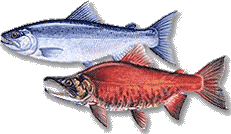Kokanee Salmon
Kokanee, also called red salmon, are the landlocked form of sockeye salmon. When confined to fresh water, as they are in New York, kokanee are the smallest of the Pacific salmon, rarely exceeding 15 inches in length or one pound. Despite their small size, kokanee are highly regarded sportfish because their orange-red flesh makes a tasty meal.
Northern pike are very adaptable and occur in a wide range of habitats. They are one of the most widely distributed freshwater fish in the world, and the only members of the pike family to occur in arctic environments. Northerns prefer weedy portions of rivers, ponds, and lakes, but large adults will often move offshore into deeper waters.
Northern pike can be distinguished from their cousins, the pickerels, by the scaleless lower half of the gill covers. Their bodies are dark green to brown with light bean-shaped spots. There is no distinct dark bar beneath the eye. The undersurface of the lower jaw has eight to 12 pores and there are often bright gold markings on both sides of the head. Northerns can grow to be quite large – the current New York State record is a 46-pound two-ounce monster taken from Great Sacandaga Lake back in 1940.


